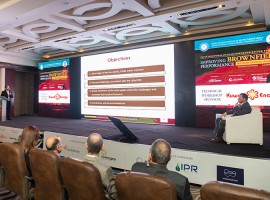By Mark Thurber, Partner, Andrews Kurth LLP
Despite the tsunami of power generation development that is currently underway throughout the world and dependent upon renewable energy technologies, more traditional thermal electricity generation strategies are still in play for a number of reasons.
The first is familiarity of technology. When total reliability and short development curves are required, governments are reluctant to move too far off of the main fairway. Some experimentation is acceptable, but there is a comfort zone of proven technology and development methods that is currently occupied only by the traditional fossil-fuel technologies. Accordingly, most governments, even in the current post-COP21 environment, are satisfied to maintain a base of traditional fossil-based generation capacity.
The second is grid reliability. In Egypt at the moment, for instance, there are discussions just underway to improve the breadth, reach, and flexibility of the national grid, and to make it more stable to accept higher proportions of non-base load generation such as wind and solar. These efforts are important to Egypt’s future, but there remains the need to bridge the gap as renewable energy continues to develop prior to taking a more prominent foothold, thus ensuring that electricity quantity and reliability is maintained, if not improved.
The third reason is cost. Under a fully base-loaded analysis, fossil fuels are cheaper than renewables, and are expected to remain so for at least in the short and medium terms. Indeed, even in the current environmental emphasis on renewable energy, the most common model for efficiency and reliability is to combine renewables with fossil-based base load technologies; accordingly, there remains a significant role for thermal generation for the foreseeable future.
The most inexpensive and politically neutral fossil-based technology is gas, which though abundant, is not universally available in all markets – it must be transported through pipelines or as LNG to reach the burner tip. Despite these transportation inefficiencies, several countries throughout the world are dependent on LNG as a primary source of fuel for electricity generation.
In some cases, LNG purchasing strategies are a permanent part of a country’s fuel acquisition strategy. Japan comes to mind, where there is no reasonable prospect of fossil fuel independence at any point in the foreseeable future. In other countries, LNG forms a bridging strategy to an eventual heavy reliance on renewable and nuclear generation, some GCC countries being prime examples. Other countries simply see fossil fuel as their long-term base load strategy and consider LNG as their fuel of preference, even though many renewable alternatives are available; Brazil is an eloquent example. In other selected cases where gas reserves are available but not fully developed, including Egypt and Pakistan, LNG purchasing arises out of a bridging strategy, a way to supply gas-fired generation assets while awaiting domestic supplies to be commercialized.
Economies, which are awaiting their own supply of gas, are frequently also concurrently contending with shortages of foreign reserves with which to purchase dollar-based fuel from abroad. In other words, price is king. In such countries, every dollar that can be saved on an LNG cargo is a precious resource that can be deployed elsewhere.
How to maximize this opportunity and minimize the cost? As is well known, LNG pricing and terms of delivery are currently at a historically soft level. Nevertheless, LNG suppliers are invariably large, sophisticated enterprises, well-equipped to continue and even expand their businesses in a down market. That said, such suppliers are being found increasingly flexible and creative, to arrive at new contracting strategies that benefit both sides. Whereas in the recent past it could be difficult or impossible for a buyer with lower sovereign ratings than the East Asian monoliths to even get a return phone call or otherwise seriously engage entrenched suppliers, most such suppliers are not only willing to sell LNG to less traditional buyers, but are willing and able to discuss certain terms in the agreements that have traditionally been assumed as inflexible and axiomatic within a gas supply contract.
Buyers, by showing flexibility on their side as well, can leverage this situation to obtain levels of price discounts that are potentially out of proportion even in the current soft market. To the extent a buyer is able to show flexibility in some of the key contract terms, recent experience has shown that there is room in the current market to further shave the purchase price for LNG. More than some competing buyers, sovereign purchasers with their access to alternate fuel supplies, lack of counter-party contract penalties or financing restrictions, and ability on the national grid to absorb swings in dispatch response, can find themselves in a favored position to offer flexible terms to LNG sellers.
Any material term in an LNG contract is open for negotiation, but special attention should be directed to the following clauses as key candidates for buyer flexibility in exchange for lower LNG pricing:
Supply Penalties — Most LNG purchase and sale agreements require the seller to provide cargoes in accordance with a delivery program that is established annually in advance of the contract year. This obligation includes timing and quantity components, and in the past has been invariably paired with penalties against the seller for default. As to timing, it is worthwhile to suppliers, who more and more are conducting business on a worldwide portfolio basis, managing a fleet of tankers, having multiple points of origin, destination, and varying schedules, to possess the flexibility to delay a cargo delivery. If the purchaser can absorb a late cargo then pricing flexibility will usually follow. Perhaps even more importantly, if a purchaser has the ability to either forego a cargo or to accept an extra cargo, this optionality can be valuable to a supplier and it is also likely to be reflected in lower purchase prices. One such structure allows a combined put/call option in favor of the supplier, i.e. the ability to “put,” or sell, one or more extra cargoes in a contract year to the purchaser, combined with the ability to “call,” or fail to deliver to the contracted purchaser one or more contracted cargoes. Another variant is providing the supplier with the optionality of early departure from the unloading berth, prior to filling the FSRU or onshore storage capacities. This allows the supplier either to mitigate risk under more restrictive contracts with other LNG buyers, or to take advantage of temporary and fluctuating market conditions in other delivery destinations. Often a supplier will offer to return with additional cargoes prior to depletion of the buyer’s inventory, making this a risk that a sovereign buyer can assume with few operating consequences.
Force Majeure — It is a basic tenet of LNG supply contracts that buyers and sellers are excused from performance under contingencies that are beyond their control, particularly as relating to natural disasters such as storms, earthquakes, and fires. A buyer that is able to offer continued fixed payments to its supplier, despite experiencing force majeure events that prevent or delay its performance, would be expected to realize price savings on the purchase of LNG, particularly if the same buyer is able, for similar reasons, to accept force majeure interruption on the seller side. In reality, the delivery of LNG cargoes is more susceptible to force majeure interruption than is the on-shore receipt of such cargoes, putting most buyers in a position to accept a greater degree of force majeure exposure. Particularly if an FSRU is deployed, force majeure on the receiving side is less likely to express in an extensive or extended footprint. For instance, pipeline ruptures are normally of temporary duration, and infrastructure failure in one part of a country, while inconvenient, does not typically imply widespread failure of the grid. There are usually workarounds, and buyers willing to assume this degree of flexibility can trade it for consideration in the pricing clause.
Term — Although the concept is still under debate, the weight of opinion is that a longer-term contract will be priced lower than a shorter-term sale, referred to in the commodities markets as a “contango” forward pricing curve. Notwithstanding currently low LNG prices, which some see as expressing a tendency toward a lower price in short-term rather than long term sales, the better opinion seems to be that (i) there is a lot of gas currently available but still shut in due to demand constraints, with much more still available to come on line, and (ii) a seller can plan its business more effectively if it has locked in a significant customer for 20 years instead of 5, even if pricing is not optimum. Thus, a buyer that is able to offer long-term purchases will likely see more flexibility in the pricing clause than a buyer bound by shorter-term considerations.
Quality — Some buyers are able to offer flexibility on the quality of LNG they are able to accept. For instance, some types of gas engines, particularly reciprocating engines, can burn fuel over a wide range of specifications, both as relating to heat content and as to contaminants. If most of the gas from a particular LNG transaction is being targeted to power plants, having flexible fuel requirements, then sellers are able to supply that particular contract from a wider range of supply sources, reserving their contracted supply sources, which meet more stringent quality requirements for other buyers that have not granted the same flexibility. Conversely, if a buyer occupies a niche in terms of its required specifications, even if narrow, it may be able to nevertheless identify a seller having access to that particular tranche of LNG supply, which is not able to readily sell it to other markets without preliminary treating. In either case, the seller saves money, resulting in pricing flexibility in the LNG supply negotiation.
The foregoing comprise a few of the terms that can be put into play by a flexible buyer and seller to reach an optimum result for both sides. Not all of the terms are available to every buyer to offer as concessions, and not all of the buyer’s flexibility represents equivalent value to every seller. But by candidly and realistically re-assessing the risk avoidance strategies traditionally assumed by most buyers and sellers as being foundational to their risk management, innovative parties can achieve many of their objectives in a modern LNG supply negotiation.








